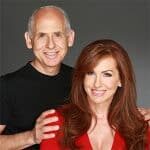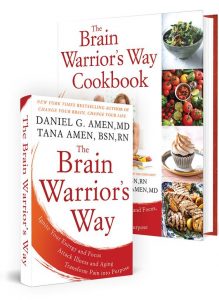Can Music to Help to Relieve Anxious Feelings?

Barry Goldstein is known for using specific tempos, keys, and frequencies in his music for healing purposes. In the final episode of a series on music and the brain, Dr. Daniel Amen and Barry go over the specific elements in music that can elicit specific responses in your brain and body. Their brand-new album, Feel Better Fast and Make It Last, is now available wherever music is sold.
Dr. Daniel Amen: Welcome to the Brain Warrior's Way Podcast. I'm Dr. Daniel Amen.
Tana Amen: And I'm Tana Amen. Here, we teach you how to win the fight for your brain, to defeat anxiety, depression, memory loss, ADHD, and addictions.
Dr. Daniel Amen: The Brain Warrior's Way Podcast is brought to you by Amen Clinics, where we've transformed lives for three decades, using brain SPECT imaging to better target treatment and natural ways to heal the brain. For more information, visit amenclinics.com.
Tana Amen: The Brain Warrior's Way Podcast is also brought to you by BrainMD, where we produce the highest quality nutraceutical products to support the health of your brain and body. For more information, visit brainmdhealth.com. Welcome to the Brain Warrior's Way Podcast.
Dr. Daniel Amen: Welcome back. I'm here with Barry Goldstein. We're talking about music and your brain. We've talked about our new album, Feel Better Fast and Make It Last. We so, hope you get it. I play it after work, if I need to relax, or if I come home and I have 100 emails, which is not uncommon for me is, I put the focus part on.
Barry Goldstein Yeah.
Dr. Daniel Amen: And that can help. Tana likes the sleep part to calm her down, calm her busy brain down at night. Since this is a brain podcast, let's talk about how this works. What are the pieces of music that really seem to make a difference in people's lives?
Barry Goldstein Yeah, I mean, I look at this when I'm creating music for this is, it's like a recipe. A recipe's not gonna be the same for every dish. And depending on where we want to target someone, that dish is gonna change. And the ingredients are gonna change with that. So, if we're trying to induce mood elevation or enhance mood, the tempo's gonna be more up, right. I'm gonna make use of major chords, which they shown through studies that people are able to decipher, even the most naïve of listeners, that major chords make them feel more happy and minor chords make them feel more sad.
Dr. Daniel Amen: So, give them examples, for people who don't really know much about music.
Barry Goldstein Okay. So, like the song Good Love, it's completely in major chords. And it's very up and motivational. The Beach Boys' song Good Vibrations are major chords. But, if you listen to Beethoven, a lot of those songs are in the minor keys, which can make you feel more sad or more reflective, which is okay. But if that's not where you're targeting, you don't want to do that in a happy piece of music, per se.
Dr. Daniel Amen: Sometimes I've read, even sad songs can make people feel happy?
Barry Goldstein Yeah. If they are based on feeling that emotion, it can be freeing, as well. Because you're processing the emotion.
Dr. Daniel Amen: Or if you go back to the song-
Barry Goldstein You're feeling lighter afterwards.
Dr. Daniel Amen: ... that you loved in a movie that was super sad, but you loved the movie.
Barry Goldstein Right.
Dr. Daniel Amen: So, like in A Star Is Born, I loved it. I saw it twice. But the last song in the movie, I think it's I'll Never Love Again, it's so sad, but it's so good.
Barry Goldstein Right.
Dr. Daniel Amen: Right, so, it's rich with memory and emotion.
Barry Goldstein And it can redefine for you, too, one song that you initially felt sad about, now you feel happy because it has a more positive experience for you.
Dr. Daniel Amen: Right. Everybody in the movie theater's crying when she sings that last song.
Barry Goldstein Right. But you feel good you come out, still.
Dr. Daniel Amen: But it's like, "Wow, that is really amazing."
Barry Goldstein Yeah. And that's what we're doing with this album. We are looking at every piece of music, what's necessary. Because music's a bridge. How am I gonna get people from point A to point B in each one of these pieces?
Dr. Daniel Amen: And so, with mood elevation, major chords.
Barry Goldstein Major chord progressions, the tempo. Because we also think of faster music as more happy. So, it's gonna be a little bit more up-tempo. And it's gonna keep them more active with the music, as well. There's more strumming guitars in there in that specific piece, as well. So, there's a lot of different elements in each one of the pieces.
Dr. Daniel Amen: How about focus?
Barry Goldstein Yeah.
Dr. Daniel Amen: Because there's a piece on this album for focus.
Barry Goldstein There's a piece on the album for focus. Now, with focus, you want to keep people to the point where they are attentive. So, it's kind of, you want to enjoy the music but you don't want to focus on it so much that you're paying attention to it. That's why lyrics are usually not good, so we're not gonna use lyrics with that. There are nature sounds-
Dr. Daniel Amen: Certainly not of me singing it.
Barry Goldstein Not me in this one either, although I do sing. But also, those nature elements can tend to mask noise in specific areas. So we use rainfall in it. We are also using specific frequencies in this one, as well, to target a more focused state. And in this piece, we're using what's called monaural beats, where you're introducing two frequencies that are targeting a specific brainwave frequency. And we are targeting what we call the zone. So, it's really peak performance and flow. So, really, even there's focus, and then as you know, with athletes, is taking them to the zone, is when they are kind of on autopilot. They're in ultra-focused states. And that's what we are doing with our focus one.
With our relaxation, when we're really using entrainment, we're using heart entrainment with that, and we are targeting about 60 beats per minute. So, if you're slowly coming down from your day, you're gonna adapt to the rhythm of the music. What's interesting with that is, they've discovered that even listing to a metronome, when a metronome is, you know that thing us musicians use, it goes back and forth, at 66-
Dr. Daniel Amen: You're relaxing me as we talk about it.
Barry Goldstein At 66 beats per minute, and this was with no music at all, that when people just listening to that metronome at 66 beats per minute, they had relieved anxiety just from listening at that tempo. So, when we're coming back down to that relaxed state, we're moving back into a parasympathetic state where we not running from the bear anymore. So, we've applied-
Dr. Daniel Amen: So, sympathetic state is a fight or flight state.
Barry Goldstein Right.
Dr. Daniel Amen: But parasympathetic is the opposite.
Barry Goldstein That's right, where you're really inducing relaxation, and your body's just going, "Ahh," which is what it does with that piece. And you're moving into a relaxed state by coming back down to that rhythm. And as we discussed, what's happening to your brain waves when your heart's slowing down and your heart rate, we've shown through research that music can slow the heart rate down, what's happening to the brain waves at the same time of that is, your brain waves are moving into more states of alpha, which is a more relaxed state, as well.
And that really sets the segue for our sleep piece, which uses a combination of really, of the focus and the relaxation piece, where we are targeting both the heart at a relaxed state, and we are also targeting Delta brain waves through again, monaural beats. And we use monaural beats, people can look that up online, but it's basically, using two frequencies to target that brainwave state. And with monaural beats, you don't have to use headphones at all, which we really wanted people not to have to use headphones before they go to sleep at night, or to move into a relaxed state. Because it's just another thing that people have to do, and sometimes, people won't do, because their headphones aren't there.
Dr. Daniel Amen: How can people get our new album, Feel Better Fast and Make It Last?
Barry Goldstein Our album is going to be available wherever music is sold. iTunes, CD Baby, and Amazon are going to be the primary ways of distributing the music. So, everyone will be able to get that.
Dr. Daniel Amen: And I also included it in the pledge package from my new show, Feel Better Fast and Make It Last.
Barry Goldstein Exactly.
Dr. Daniel Amen: And it looks great, friend. The cover's awesome.
Barry Goldstein Yeah. It's beautiful. It's a beautiful package.
Dr. Daniel Amen: I know you worked really hard on this. Thank you so much-
Barry Goldstein My pleasure.
Dr. Daniel Amen: ... for helping us bring brain-elevating music to [inaudible 00:08:52].
Barry Goldstein Exactly.
Dr. Daniel Amen: Thank you for listening to the Brain Warrior's Way contest. Go to iTunes and leave a review, and you'll automatically be entered into a drawing to get a free signed copy of the Brain Warrior's Way and the Brain Warrior's Way cookbook we give away every month.

